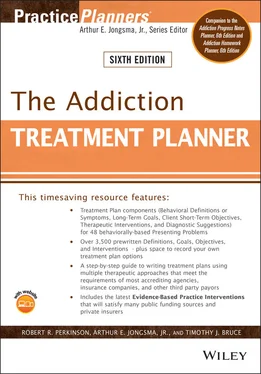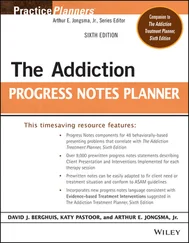The Addiction Treatment Planner
Здесь есть возможность читать онлайн «The Addiction Treatment Planner» — ознакомительный отрывок электронной книги совершенно бесплатно, а после прочтения отрывка купить полную версию. В некоторых случаях можно слушать аудио, скачать через торрент в формате fb2 и присутствует краткое содержание. Жанр: unrecognised, на английском языке. Описание произведения, (предисловие) а так же отзывы посетителей доступны на портале библиотеки ЛибКат.
- Название:The Addiction Treatment Planner
- Автор:
- Жанр:
- Год:неизвестен
- ISBN:нет данных
- Рейтинг книги:4 / 5. Голосов: 1
-
Избранное:Добавить в избранное
- Отзывы:
-
Ваша оценка:
- 80
- 1
- 2
- 3
- 4
- 5
The Addiction Treatment Planner: краткое содержание, описание и аннотация
Предлагаем к чтению аннотацию, описание, краткое содержание или предисловие (зависит от того, что написал сам автор книги «The Addiction Treatment Planner»). Если вы не нашли необходимую информацию о книге — напишите в комментариях, мы постараемся отыскать её.
The Addiction Treatment Planner, Sixth Edition
The Additction Treatment Planner, Sixth Edition
The Addiction Treatment Planner — читать онлайн ознакомительный отрывок
Ниже представлен текст книги, разбитый по страницам. Система сохранения места последней прочитанной страницы, позволяет с удобством читать онлайн бесплатно книгу «The Addiction Treatment Planner», без необходимости каждый раз заново искать на чём Вы остановились. Поставьте закладку, и сможете в любой момент перейти на страницу, на которой закончили чтение.
Интервал:
Закладка:
In addition to this list, we believe that many of the Goal, Objective, and Intervention statements found in the chapters reflect a recovery orientation. For example, our assessment interventions are meant to identify how the problem affects this unique client and the strengths that the client brings to the treatment. In addition, an intervention statement such as, “Help the client to see the new hope that addiction treatment brings to the resolution of interpersonal conflicts” from the “Suicidal Ideation” chapter is evidence that recovery model content, such as the principle of hope, permeates items listed throughout our chapters. However, if the clinician desires a more focused set of statements directly related to each principle guiding the recovery model, they can be found in Appendix B.
We have done a bit of reorganizing of chapter content for this edition. We have renamed the “Unipolar Depression” chapter to become “Depression – Unipolar.” A new chapter entitled “Opioid Use Disorder” is returned as a separate chapter due to the epidemic use of this drug that is sweeping the country. “Opioids were involved in 46,802 overdose deaths in 2018 (69.5% of all drug overdose deaths). Two out of three (67.0%) opioid-involved overdose deaths involve synthetic opioids.” (Hedegaard, Miniño, & Warner, 2020; Wilson, Kariisa, Seth, Smith, & Davis, 2020). In recognition of the seriousness of this societal problem we have created a chapter to address this issue.
We have updated the Diagnostic Suggestions section at the end of each chapter by deleting all references to DSM-IV and ICD-9. Since the date for mandatory use of DSM-5 (ICD-10-CM) codes and labels for billing purposes was October 2014, we have removed the transitional content of DSM-IV.
At the end of each chapter's list of objectives and interventions there is a reference to administration of a client satisfaction survey. Appendix Dcontains resource material for examples of various types of satisfaction assessment instruments.
Lastly, some clinicians have asked that the objective statements in this Planner be written such that the client's attainment of the objective can be measured. We have written our objectives in behavioral terms and many are measurable as written. For example, this objective from the “Anxiety” chapter is one that is measurable as written because it either can be done or it cannot: “Verbalize an understanding of the cognitive, physiological, and behavioral components of anxiety and its treatment.” But at times the statements are too broad to be considered measurable. Consider, for example, this objective from the “Anxiety” chapter: “Identify, challenge, and replace biased, fearful self-talk with positive, realistic, and empowering self-talk.” To make it quantifiable a clinician might modify it to read, “Give two examples of identifying, challenging, and replacing biased, fearful self-talk with positive, realistic, and empowering self-talk.” Clearly, the use of two examples is arbitrary, but it does allow for a quantifiable measurement of the attainment of the objective. Or consider this example reflecting a behavioral activation objective: “Identify and engage in pleasant activities on a daily basis.” To make it more measurable the clinician might simply add a desired target number of pleasant activities, thus: “Identify and report engagement in two pleasant activities on a daily basis.” The exact target number that the client is to attain is subjective and should be selected by the individual clinician in consultation with the client. Once the exact target number is determined, then our content can be very easily modified to fit the specific treatment situation. For more information on psychotherapy treatment plan writing, see Jongsma (2005).
We hope you find these improvements to this sixth edition of the Planner useful to your treatment planning needs.
HOW TO USE THIS TREATMENT PLANNER
Use this Treatment Planner to write treatment plans according to the following progression of six steps:
1 Problem Selection. Although the client may discuss a variety of issues during the assessment, the clinician must determine the most significant problems on which to focus the treatment process. Usually a primary problem will surface, and secondary problems may also be evident. Some other problems may have to be set aside as not urgent enough to require treatment at this time. An effective treatment plan can only deal with a few selected problems or treatment will lose its direction. Choose the problem within this Planner that most accurately represents your client's presenting issues.
2 Problem Definition. Each client presents with unique nuances as to how a problem behaviorally reveals itself in his or her life. Therefore, each problem that is selected for treatment focus requires a specific definition about how it is evidenced in the particular client. The symptom pattern should be associated with diagnostic criteria and codes such as those found in the DSM-IV-TR or the International Classification of Diseases. This Planner offers such behaviorally specific definition statements to choose from or to serve as a model for your own personally crafted statements.
3 Goal Development. The next step in developing your treatment plan is to set broad goals for the resolution of the target problem. These statements need not be crafted in measurable terms but can be global, long-term goals that indicate a desired positive outcome to the treatment procedures. This Planner provides several possible goal statements for each problem, but one statement is all that is required in a treatment plan.
4 Objective Construction. In contrast to long-term goals, objectives must be stated in behaviorally measurable language so that it is clear to review agencies, health maintenance organizations, and managed care organizations when the client has achieved the established objectives. The objectives presented in this Planner are designed to meet this demand for accountability. Numerous alternatives are presented to allow construction of a variety of treatment plan possibilities for the same presenting problem.
5 Intervention Creation. Interventions are the actions of the clinician designed to help the client complete the objectives. There should be at least one intervention for every objective. If the client does not accomplish the objective after the initial intervention, new interventions should be added to the plan. Interventions should be selected on the basis of the client's needs and the treatment provider's full therapeutic repertoire. This Planner contains interventions from a broad range of therapeutic approaches, and we encourage the provider to write other interventions reflecting his or her own training and experience.Some suggested interventions listed in the Planner refer to specific books that can be assigned to the client for adjunctive bibliotherapy. Appendix Acontains a full bibliographic reference list of these materials. Many references to homework interventions are found in each chapter. The sources for these assignments can be found in the books listed in the general references at the beginning of Appendix A. For further information about self-help books, mental health professionals may wish to consult Self-Help That Works: Resources to Improve Emotional Health and Strengthen Relationships (Norcross et al., 2013).
6 Diagnosis Determination. The determination of an appropriate diagnosis is based on an evaluation of the client's complete clinical presentation. The clinician must compare the behavioral, cognitive, emotional, and interpersonal symptoms that the client presents with the criteria for diagnosis of a mental illness condition as described in DSM-IV-TR. Despite arguments made against diagnosing clients in this manner, diagnosis is a reality that exists in the world of mental health care, and it is a necessity for third-party reimbursement. It is the clinician's thorough knowledge of DSM-IV-TR criteria and a complete understanding of the client assessment data that contribute to the most reliable, valid diagnosis.
Читать дальшеИнтервал:
Закладка:
Похожие книги на «The Addiction Treatment Planner»
Представляем Вашему вниманию похожие книги на «The Addiction Treatment Planner» списком для выбора. Мы отобрали схожую по названию и смыслу литературу в надежде предоставить читателям больше вариантов отыскать новые, интересные, ещё непрочитанные произведения.
Обсуждение, отзывы о книге «The Addiction Treatment Planner» и просто собственные мнения читателей. Оставьте ваши комментарии, напишите, что Вы думаете о произведении, его смысле или главных героях. Укажите что конкретно понравилось, а что нет, и почему Вы так считаете.












